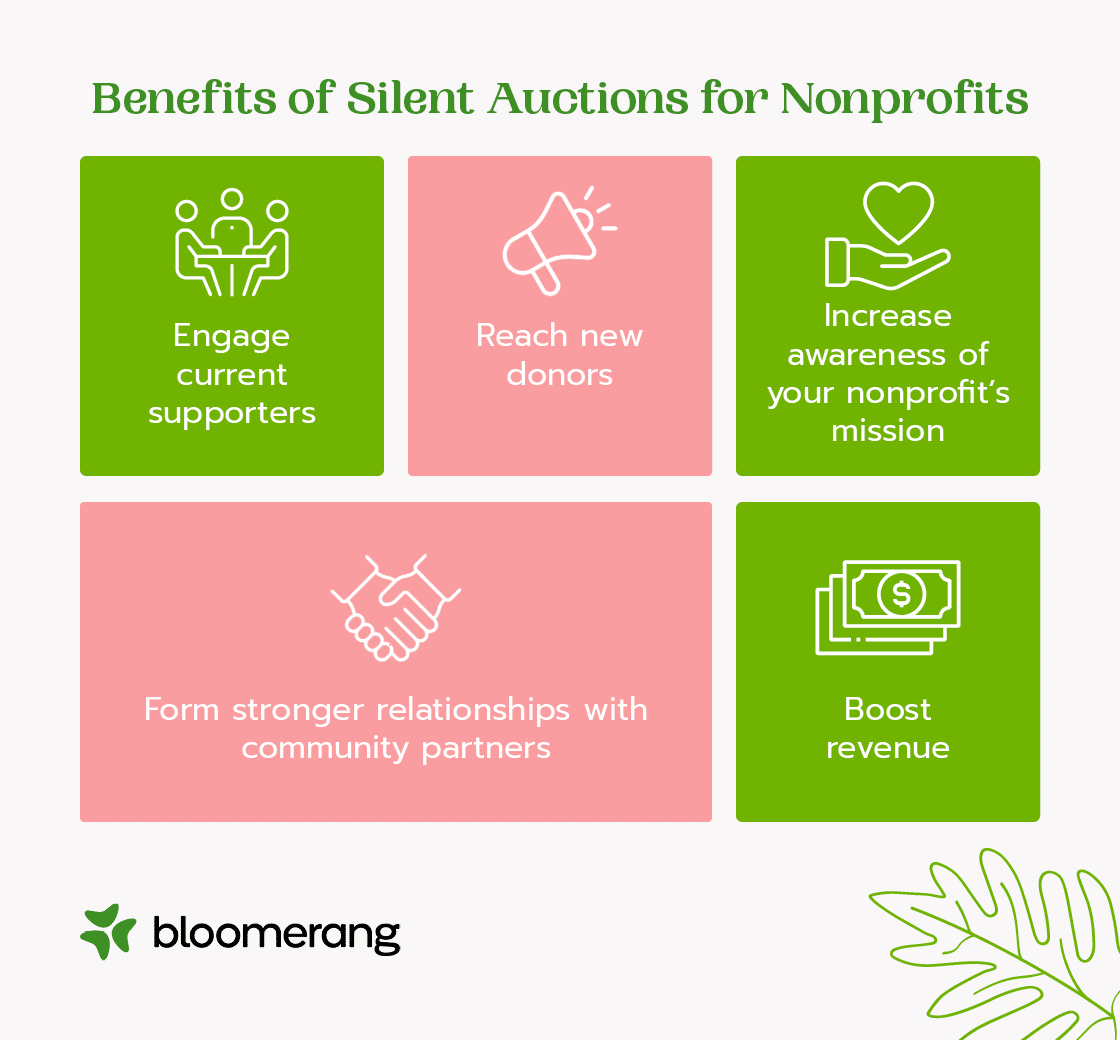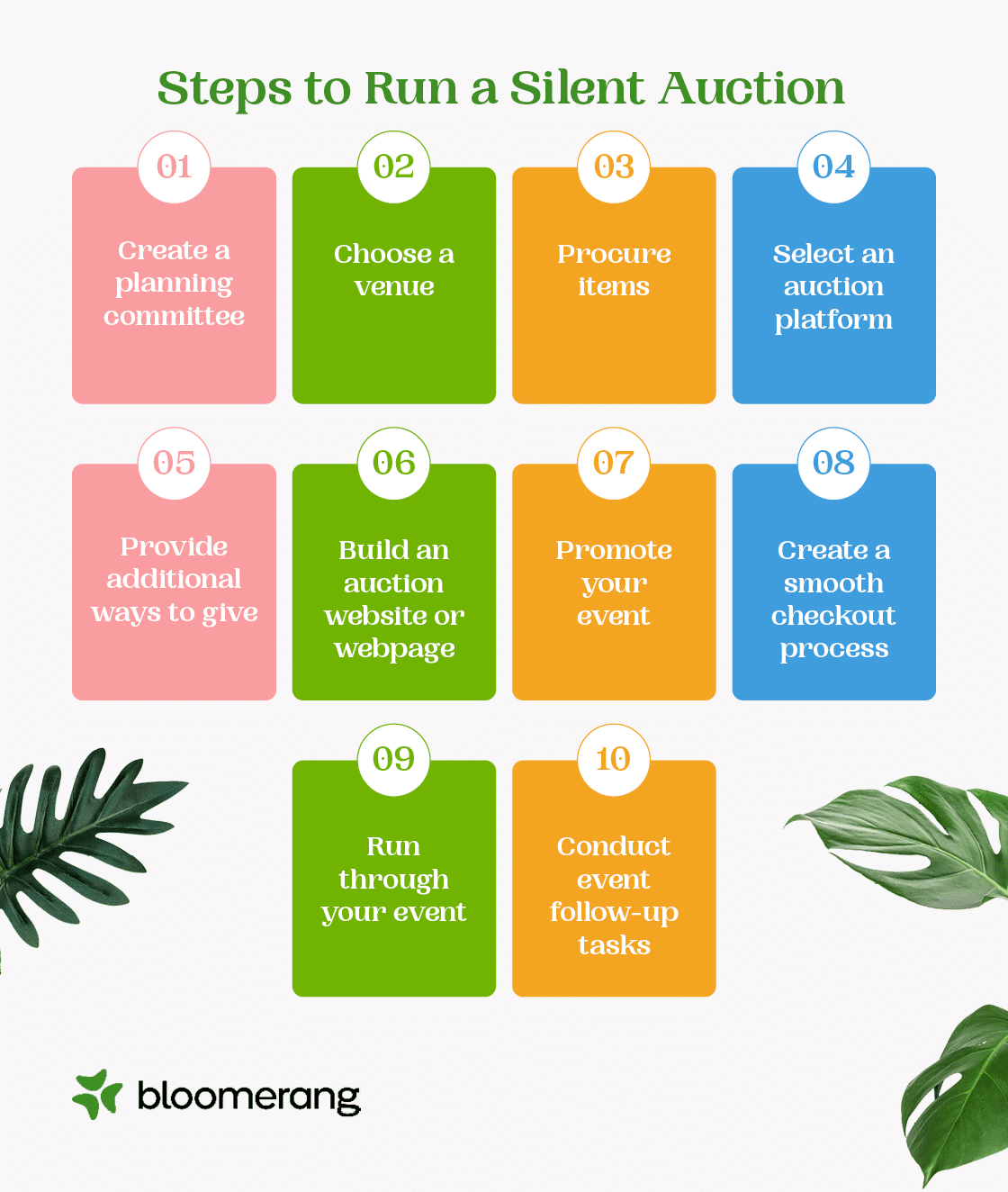How to Run a Silent Auction: 10 Simple Steps for Success



From peer-to-peer fun runs to bake sales, there’s no end to the types of fundraising events your nonprofit can host. Planning events is one of the best ways to raise money for your mission, and donors love participating in them. In fact, 81% of nonprofit donors attend fundraising events.
Silent auctions are a great fundraising event format if you want a unique way to engage your donors. These highly interactive experiences allow your nonprofit ample time to engage with supporters face-to-face.
This guide covers the following tips and steps to help you run a successful silent auction:
First, let’s define exactly what a silent auction entails to give you a better understanding of how these events work.
A silent auction is a fundraising event where attendees bid on auction items using mobile bidding software or paper bid sheets. Rather than having an auctioneer announce items, attendees can freely walk around the event to view items.
You can host a silent auction either in person or online. With an in-person event, attendees browse items displayed on a table and place bids on their favorites using paper bid sheets or a mobile bidding platform. In a virtual silent auction, supporters view auction items on a website or webpage and place bids online.
As a particularly engaging type of fundraising event, silent auctions offer many benefits for nonprofits. Hosting a silent auction allows your nonprofit to:

Silent auctions may require a bit more planning than other fundraising events, but the effort is worth it because of these significant benefits.
If you’ve never hosted a fundraising silent auction before, it may seem intimidating. But when you break down the process into smaller steps, you can simplify planning and make the process much easier for your auction committee. Let’s explore the main steps of running a silent auction.

The first step in planning your silent auction is recruiting a dedicated team of passionate staff members and volunteers to organize your event. The majority of your planning committee will likely be comprised of internal staff members from your nonprofit’s fundraising team. However, if you need more support, reach out to your supporter network for volunteers—especially if you’ve had people mention their interest in helping you plan events in the past.
Assign the following initial tasks to your planning committee members:
Then, work with your planning committee to check the other items off this to-do list. Establish open communication with your team using an instant messaging system or email cadence to keep everyone on the same page.
If you’re hosting an in-person or hybrid event, you’ll need to find the perfect venue to host your fundraiser. Your quest for the right venue for your fundraising auction depends on several factors:
As you’re picking your venue, also keep in mind what entertainment options you want for your guests. If you know any local musicians or bands willing to play a set or a local comedian willing to perform a standup routine, try to find a venue with a good stage area. Providing entertainment for your guests will keep your auction fun and engaging.
Bonus tip: Strategize ways to make the event layout visually appealing.
Just like you’re more likely to purchase something that is presented in a visually appealing way at a store, making your auction look nice can result in a higher perceived value and higher bids! Jazz up your event space with themed decor or soft lighting that adds ambiance.
Finding items for your auction guests to bid on can be stressful if you don’t know where to look. Luckily, your nonprofit likely has corporate partners and donors in your area who’d be excited to support your event. Use these strategies to gather valuable, unique auction items:
If you need help determining which items will be most enticing for your guests, don’t hesitate to ask! Send a pre-event survey asking for suggestions or encouraging supporters to rank their interest in potential items. This can help you narrow down your search and be more specific when requesting donations from corporate partners.
Bonus tip: Consider picking a theme for your items.
A theme can tie your items together and make your event more memorable. Consider theme options like Winter Wonderland, Summer Splash, or Outdoor Adventure.
Thanks to advancements in the event fundraising technology world, paper bidding is no longer the only way to bid on silent auction items. Auction software makes bidding easy for your organization and your auction guests.
In a traditional auction, your guests use bid sheets placed next to items to write down their name and bid amount. However, with mobile and online bidding, guests can bid directly from their smartphones or web browsers no matter where they are, making virtual or hybrid auctions easy to run. You never need to worry about losing pens or ripped bid sheets ever again.
When choosing an auction platform, there are a few factors to consider:
For example, Qgiv’s auction software is great for all organizations, big and small. It’s simple to use, includes award-winning customer support, and offers unlimited users, allowing large organizations to add as many accounts as they need. Plus, with Qgiv, you can set up as many auction events as you’d like, ensuring you can host multiple events throughout the year.
The auction itself will be your organization’s primary fundraising method, but that doesn’t mean you can’t incorporate other strategies to raise even more from your event.
In fact, not all of your guests will have placed bids or won items. To maximize your fundraising, implement additional revenue-generating strategies at your silent auction.
Let’s briefly look at a few of the most popular options:
With these additional revenue streams, every attendee can leave knowing they contributed to your mission’s success.
Once you’ve put the details of your auction together, make it easy for your guests to find information about the amazing experience you have planned. Building a website or online event page means you can point your guests to a one-stop shop whenever anyone has questions about your event.
Your digital resource should include:
Share links to your auction website in your digital and traditional marketing materials (read on to the next section for event marketing tips).
A thorough event promotion strategy will help increase RSVPs for your event, leading to greater fundraising potential. These channels can come in handy to help get the word out:
Increase your event outreach in the weeks and days before the auction to boost excitement and ensure everyone who may be interested has a chance to see the event’s details.
Bonus tip: Personally invite specific guests to your auction event.
Some supporters would be incredibly valuable guests to invite to your event. This includes major donors, who could potentially help you raise a lot of money through bidding on big-ticket items. Personally invite these supporters to your event with a handwritten note or phone call. Let them know you’d love to catch up with them at the event and get their take on your organization’s recent mission-related efforts.
Your fundraising auction software should be able to help you arrange the items in a way that makes it easy for your supporters to see and bid on items. To make the checkout process smoother, once an item has been pulled, pull the item’s sign with it so you can keep a visual tally of what items are left to be picked up. Let your supporters know how to claim their items if they purchased them online or had to leave the event before the auction closed.
Bonus tip: Make sure your auction software offers a secure payment processing system.
Your payment processor should have security measures in place such as PCI compliance and data encryption. This gives donors a smooth, painless, trustworthy checkout process.
As the big day approaches, your planning committee should conduct a practice run of your event so you can iron out any potential issues you may encounter during the auction. Prioritize the following tasks during your run-through:
At the end of the day, organization and communication are key when throwing a successful fundraising auction. Brainstorm with your team any pitfalls that may arise during the event and plan ahead for how to avoid them and what you could do if an issue takes place.
Bonus tip: Don’t crowd your tables.
If you’re throwing an in-person event, make sure your items are evenly spaced. They shouldn’t be crowded together at the same table because this will overwhelm your guests and may result in certain items being overlooked. When arranging your items, consider alternating items like gift cards and larger physical items so the tables don’t get too crowded with just one type of item.
After your auction has concluded and the last gift has been picked up by a winning bidder, your work isn’t over quite yet. To knock your event process out of the park, be sure to conduct the following wrapping-up tasks:
Planning this auction was a valuable experience for your organization, so don’t let what you’ve learned go to waste. Your next auction can be even more phenomenal.
Planning an auction is hard work, but as a special event that engages and excites your guests, the payoff is well worth it. If you’re looking for even more tips to help you host a successful event, here are a few blog posts to check out:


Comments